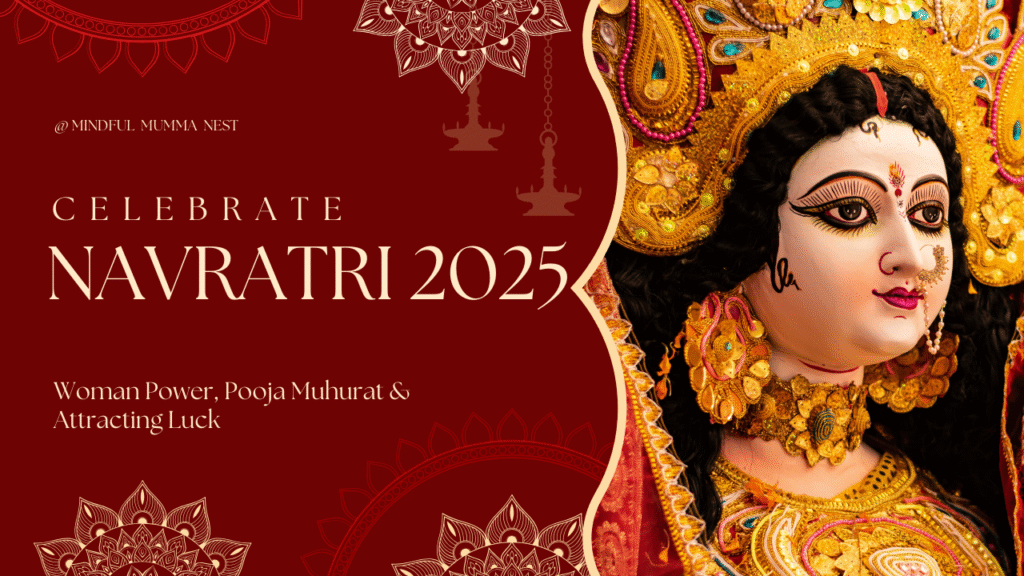Dedicating to Naari Shakti in This Navratri 2025
Why These Rituals Began
Dedicating to Naari Shakti in This Navratri
She rises with strength, fierce yet kind,
The power of home, heart, and mind.
Not just in puja, but every day’s hour,
Woman is the world’s eternal power.
At Mindful Mumma Nest, we bow to every woman, respecting and promoting them in all possible ways.
Introduction
Navratri is not just a festival — it is the living heartbeat of devotion, power, and culture. From North India to Bengal, Gujarat to the South, every region celebrates the strength of Maa Durga in unique, vibrant ways. And just like the Goddess, every woman is the Shakti of her family, her children, her home, and this world.
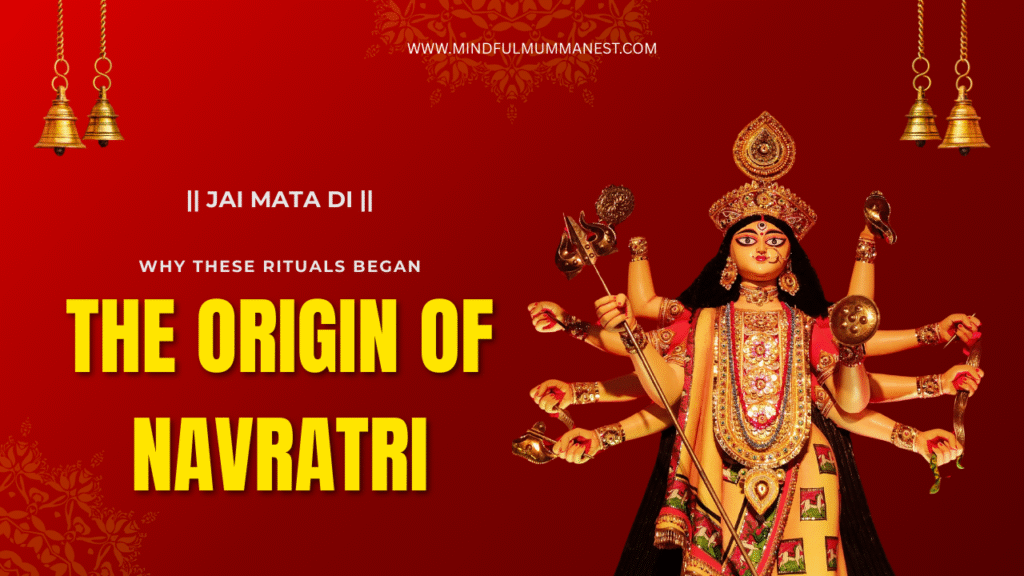
The Origin of Navratri: Why These Rituals Began
The roots of Navratri go back to the Devi Mahatmya in the Markandeya Purana. According to ancient scriptures, the gods were helpless before demons like Mahishasura. To protect creation, all gods gave their powers to form Maa Durga — a warrior goddess embodying Shakti.
For ten days and nights, she battled asuras — Chanda, Munda, Shumbha, Nishumbha, Raktabeej, and finally Mahishasura. On the tenth day (Vijaya Dashami), she triumphed, symbolizing the eternal victory of good over evil.
This story reminds us that every woman carries the power of all gods within her. She is not to be respected only in Navratri, but every single day.
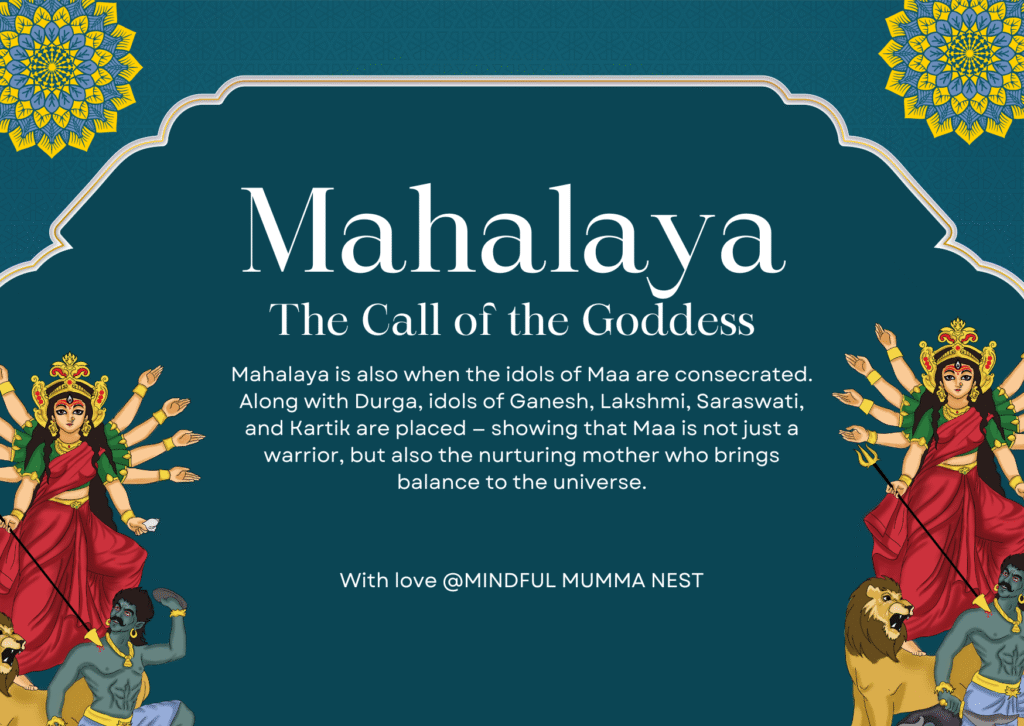
Mahalaya: The Call of the Goddess
In West Bengal, Navratri begins with Mahalaya — the day Bengalis believe Maa Durga leaves her heavenly abode to visit her earthly home.
- Priests chant the Chandi Path at dawn.
- Artists draw alpona (sacred motifs) on the ground.
- Families awaken before sunrise to listen to Birendra Krishna Bhadra’s voice on radio — the soul of Mahalaya.
Mahalaya is also when the idols of Maa are consecrated. Along with Durga, idols of Ganesh, Lakshmi, Saraswati, and Kartik are placed — showing that Maa is not just a warrior, but also the nurturing mother who brings balance to the universe.
Like Maa, every woman is a warrior, nurturer, and protector. Respect her in daily life, not just during pujas.
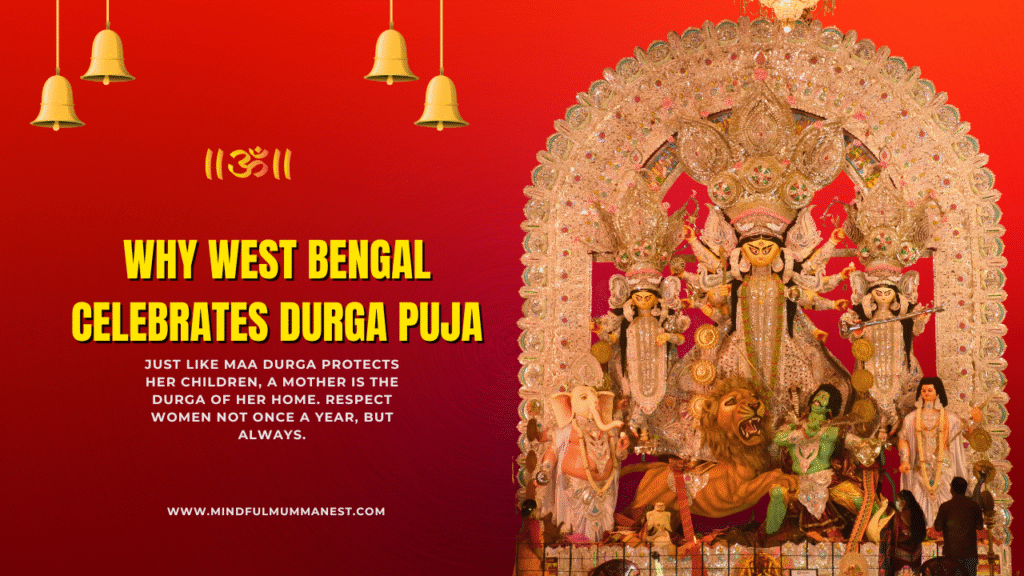
Why West Bengal Celebrates Durga Puja with Such Joy
Durga Puja is more than a festival in Bengal — it is homecoming, culture, and devotion in one.
- Sandhi Puja: The sacred moment between Ashtami and Navami, when Maa transformed into Chamunda to slay Chanda and Munda.
- Pushpanjali (Anjali): Devotees offer flowers with folded hands, seeking blessings for family and peace.
- Maha Ashtami: The most powerful day, when the entire city vibrates with prayers and dhak drums.
- Offerings to Maa: Bhog includes khichuri, labra (mixed vegetables), sweets like rasgulla, mishti doi, narkel naru, and fruits.
In 2025, Kolkata’s pandals will again showcase art, devotion, and tradition, making it the cultural highlight of India.
Just like Maa Durga protects her children, a mother is the Durga of her home. Respect women not once a year, but always.
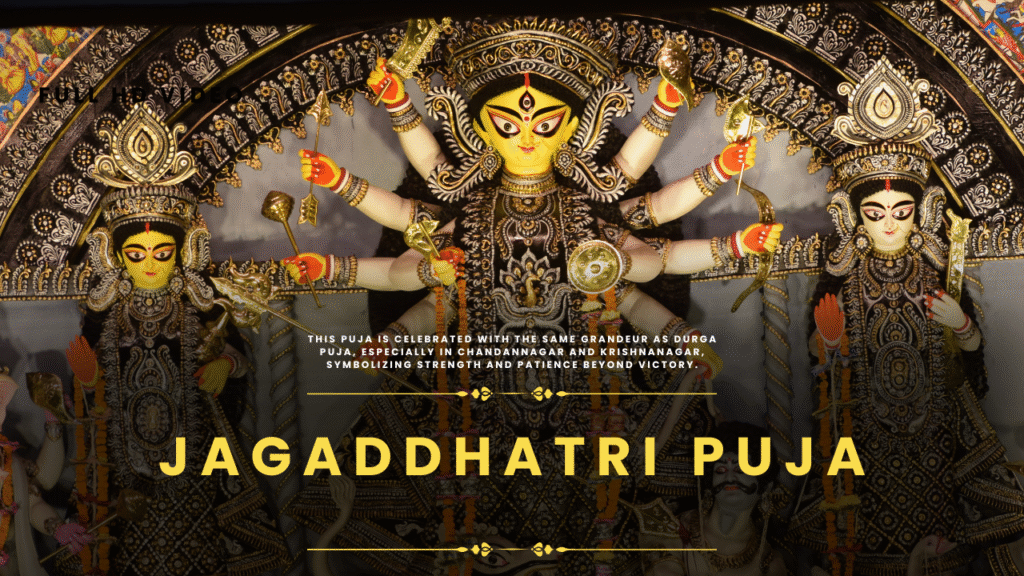
Jagaddhatri Puja: The Sister Festival After Diwali
Not many outside Bengal know that after Diwali, Jagaddhatri Puja takes place. Jagaddhatri means the Protector of the World. She is believed to appear when arrogance rises again, reminding humanity to stay humble.
This puja is celebrated with the same grandeur as Durga Puja, especially in Chandannagar and Krishnanagar, symbolizing strength and patience beyond victory.
A woman too is Jagaddhatri in her home — protecting, guiding, and keeping balance for her family.
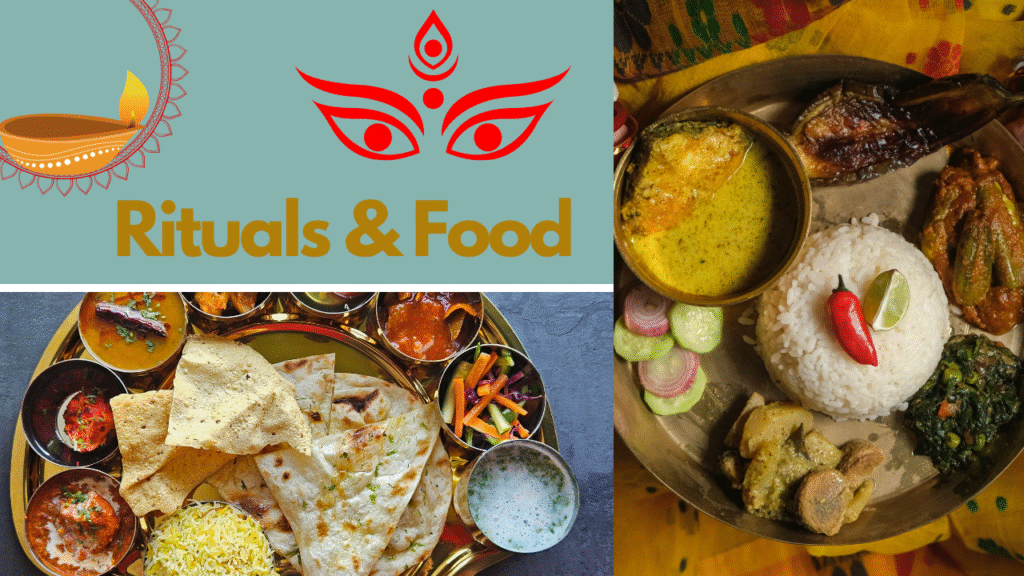
Rituals & Food: Different Perspectives
- In North India, devotees fast, eat sattvik food, and avoid non-veg as a mark of purity.
- In Bengal, eating fish and meat is not taboo — because Maa herself defeated demons by drinking Raktabeej’s blood, symbolizing strength.
At Mindful Mumma Nest Care, we respect both traditions. Rituals may differ, but devotion is the same.
Similarly, a woman’s choices in daily life deserve respect — her strength and her nurturing power go hand in hand.
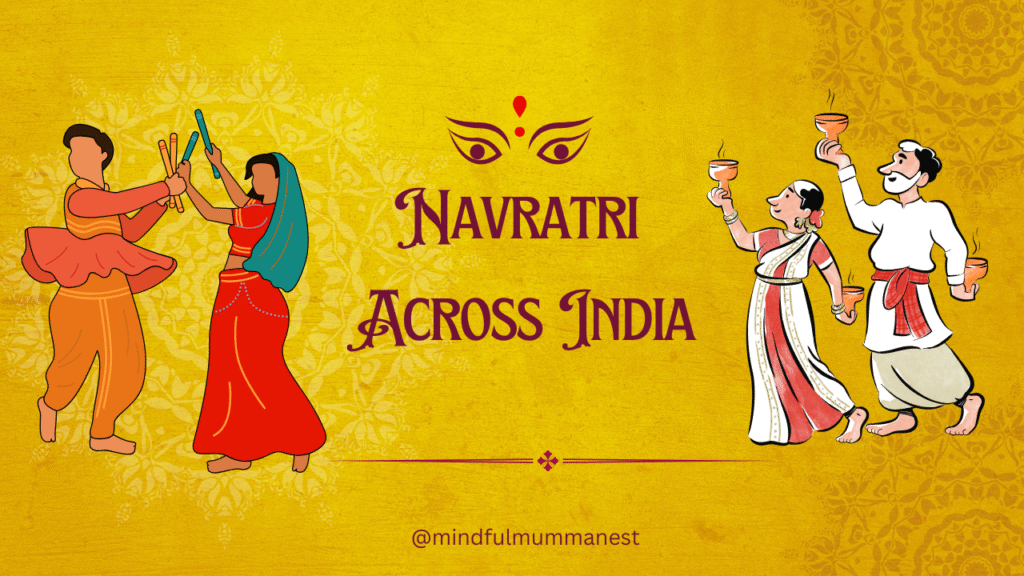
Navratri Across India: Different Shades of the Same Faith
North India
- Kalash Sthapana (Ghatasthapana): Marks the beginning of Navratri by placing a sacred pot.
- 2025 Muhurat: 29th September, between 6:12 AM – 8:35 AM (ideal time).
- 2025 Muhurat: 29th September, between 6:12 AM – 8:35 AM (ideal time).
- Kanjak Puja: On the 8th or 9th day, little girls are worshipped as the embodiment of the Goddess, offered halwa, puri, and chana.
- Haryali Navratri: In some regions, it marks the green, fertile start of the monsoon Navratri.
Gujarat
- Nights come alive with Garba and Dandiya Raas.
- Women in colorful chaniya cholis and men in kediyu dance around the earthen lamp (garbo), symbolizing Shakti.
- Gujarat’s Navratri is one of the longest dance festivals in the world.
Across regions, the message is the same: woman is Shakti, whether in puja, dance, or home. Do not just honor her in Kanjak Puja — honor her every day.
Sacred Meaning of the Goddess
Maa Durga is not just a deity — she is the symbol of every woman. Her power comes from all gods, showing that woman is the sum of all strengths.
Without women, there is no creation, no family, no earth.
This Navratri, let us celebrate women as Shakti — protectors, nurturers, creators.
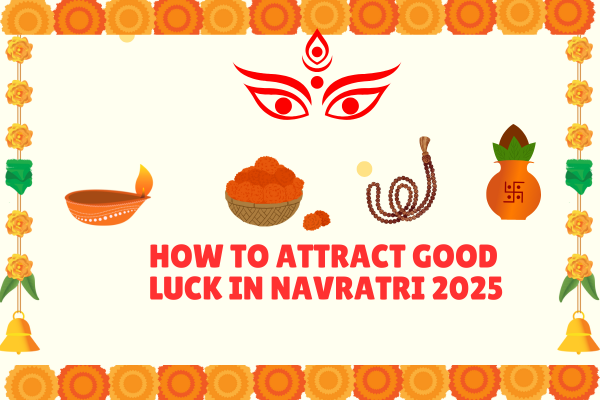
How to Attract Good Luck in Navratri 2025
- Light a ghee lamp at dawn and dusk.
- Offer fresh flowers daily.
- Chant the Durga Saptashati or 108 names of Durga.
- Keep the Kalash filled with water, mango leaves, and coconut to invite prosperity.
- Practice gratitude — the true key to attracting blessings.
Just as Maa brings blessings, a woman brings luck and prosperity into every family. Respect her always.
Ancient Stories of the Goddess
Each form of Maa Durga reflects a lesson:
- Shailputri: Rooted strength
- Brahmacharini: Devotion
- Katyayani: Courage
- Kaalratri: Fearlessness
- Siddhidatri: Divine wisdom
These nine forms remind us that every woman carries infinite powers within.
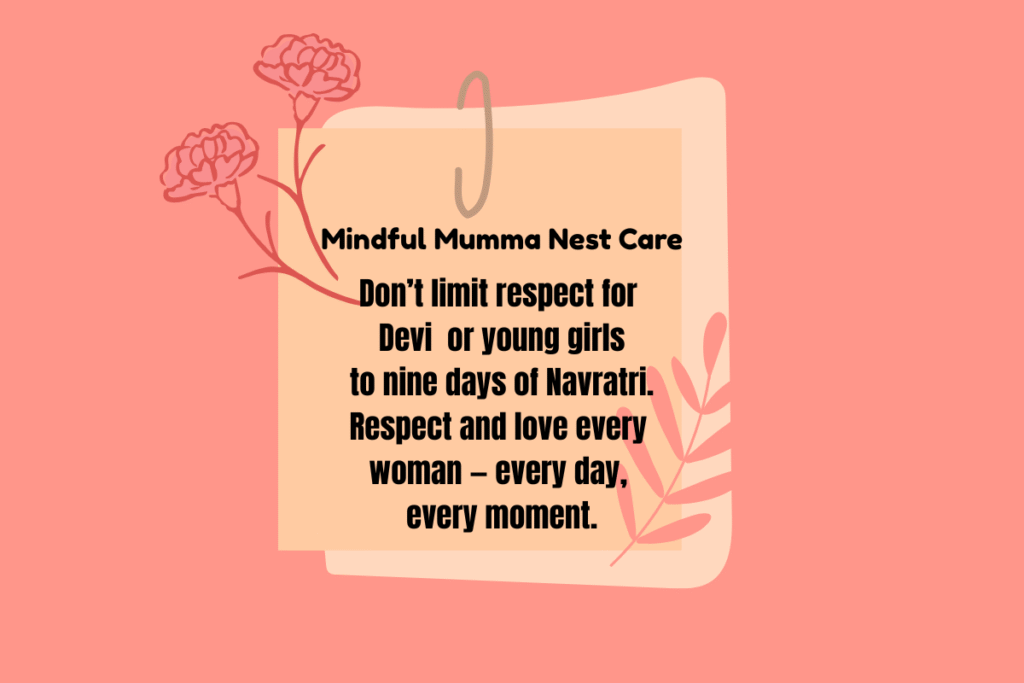
Final Words with Mindful Mumma Nest Care
Navratri is a celebration of faith, feminine strength, and cultural unity. Whether you celebrate with fasting, dancing, or puja offerings — the message is the same: honor Shakti, honor women, honor life.
Don’t limit respect for Devi or young girls to nine days of Navratri. Respect and love every woman — every day, every moment.
At Mindful Mumma Nest Care, we share not just stories, but wisdom that strengthens families with culture, respect, and mindful living.
Top 5 FAQs about Navratri 2025
1. What is the meaning of Navratri?
Navratri celebrates the victory of good over evil and honors Maa Durga’s nine forms, symbolizing the power of every woman.
2. Why is Durga Puja so grand in West Bengal?
It marks Maa Durga’s homecoming during Mahalaya, with rituals like Sandhi Puja, Anjali, and Maha Ashtami celebrated vibrantly.
3. What is the Kalash Sthapana Muhurat for 2025?
Kalash Sthapana (Ghatasthapana) is on 29th September 2025, between 6:12 AM – 8:35 AM, inviting prosperity and divine blessings.
4. Can non-veg be eaten in Navratri?
North India follows sattvik fasting, while Bengal sees fish and meat as sacred, linking to Maa Durga’s victory over demons.
5. How can we attract good luck in Navratri 2025?
Light diyas, offer flowers, chant Durga mantras, keep a Kalash, and respect women — the true form of Shakti and blessings.
Sources & Tools
- Scriptures: Devi Mahatmya, Chandi Path, Markandeya Purana
Cultural Practices: West Bengal Durga Puja Committees, North Indian Navratri rituals, Gujarat Garba associations

